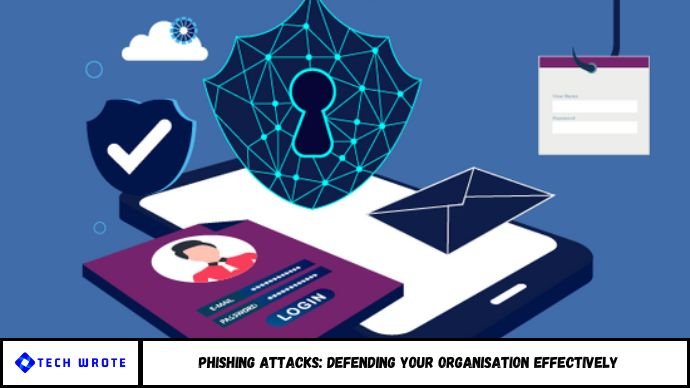Phishing attacks remain one of the most dangerous and costly cyber threats to modern organisations. This article explores how to defend your organisation against phishing with proactive strategies, employee education, updated tools, and real-world best practices. Learn how to reduce risk, improve response time, and strengthen your cybersecurity posture.
In 2024 alone, phishing attacks accounted for over 36% of all data breaches, according to Verizon’s Data Breach Investigations Report. A single click on a fraudulent email link can expose confidential information, disrupt operations, or cost your organisation millions in damage.
Despite increasing awareness, phishing tactics have evolved—becoming more sophisticated, harder to detect, and more targeted. This article will show you how to defend your organisation through a combination of employee awareness, technical safeguards, and incident response strategies.
1. What Is a Phishing Attack?
Phishing is a form of social engineering where attackers deceive users into revealing sensitive data like passwords, banking info, or access credentials—often through fake emails, texts, or websites.
Common types of phishing include:
- Email phishing: Mass emails pretending to be from legitimate sources
- Spear phishing: Highly targeted emails tailored to specific individuals
- Whaling: Attacks targeting executives or high-level staff
- Smishing: Phishing via SMS or text messages
- Vishing: Voice-based phishing using phone calls or voicemail
Understanding these variants is the first step in building a strong defense.
2. Why Phishing Works: Psychological and Technical Triggers
Attackers exploit human emotion—urgency, fear, trust, or curiosity—to bypass logic and caution.
Key tactics include:
- Spoofed sender addresses that appear legitimate
- Fake login pages that mimic company portals
- Urgent requests like “update your account” or “invoice overdue”
These tricks often slip past spam filters, especially when they’re personalized and well-researched.
3. The Cost of a Successful Phishing Attack
The financial impact can be devastating:
- IBM’s 2024 report shows the average cost of a phishing breach is $4.91 million
- 90% of data breaches start with phishing
- Ransomware is increasingly delivered through phishing emails
Beyond financial loss, phishing can damage reputation, lead to legal issues, and result in operational downtime.
4. Building a Strong Human Firewall
Your employees are both your first line of defense and your biggest vulnerability.
How to train your team effectively:
- Regular phishing simulations to test and reinforce awareness
- Interactive cybersecurity training tailored by role or department
- Clear reporting procedures for suspected phishing attempts
- Visible reminders like posters, alerts, or internal newsletters
A well-trained workforce can reduce phishing click rates by up to 80%, according to Proofpoint.
5. Technical Defenses That Strengthen Security
Technology complements human vigilance. Use a multi-layered approach:
Essential technical tools:
- Email filtering and spam detection tools with AI-based analysis
- Multi-factor authentication (MFA) to prevent account compromise
- Endpoint protection software to detect and quarantine threats
- Domain-based Message Authentication (DMARC) to block spoofed emails
- URL rewriting tools to detect suspicious links in real time
These systems detect, isolate, and neutralize threats—often before they reach users.
6. Developing a Phishing Response Plan
When an attack slips through, rapid response can limit damage.
What your incident response plan should include:
- Immediate account lockdown procedures
- Forensics and audit trails to trace the breach
- Internal communication to contain misinformation and panic
- External notifications if customer or partner data is compromised
- Post-incident review to improve defenses and training
Preparedness reduces response time and long-term fallout.
FAQs
1. What is the most common form of phishing?
Email phishing remains the most widespread, using fake emails to steal credentials or install malware.
2. How often should employees be trained on phishing?
Quarterly simulations and annual formal training are recommended for optimal effectiveness.
3. Can technology alone stop phishing attacks?
No. While tools help, human awareness is crucial to spotting sophisticated phishing attempts.
4. What should I do after a phishing breach?
Initiate your incident response plan, notify stakeholders, and review logs to identify compromised data.
5. Is phishing only an issue for large businesses?
No. Small and mid-sized businesses are often targeted due to weaker security protocols.
6. How do I know if an email is a phishing attempt?
Look for odd sender addresses, spelling errors, unusual requests, and mismatched URLs.
Conclusion
Phishing attacks are not going away—they’re becoming more dangerous. But your organisation can stay ahead by building a resilient security culture, investing in robust technical tools, and responding quickly to incidents.
In today’s digital world, every employee click matters. Don’t wait for a breach to act—start defending your organisation against phishing today with a proactive, layered strategy.


